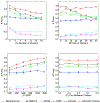Robust Empirical Bayesian Reconstruction of Distributed Sources for Electromagnetic Brain Imaging
- PMID: 31380750
- PMCID: PMC7446954
- DOI: 10.1109/TMI.2019.2932290
Robust Empirical Bayesian Reconstruction of Distributed Sources for Electromagnetic Brain Imaging
Abstract
Electromagnetic brain imaging is the reconstruction of brain activity from non-invasive recordings of the magnetic fields and electric potentials. An enduring challenge in this imaging modality is estimating the number, location, and time course of sources, especially for the reconstruction of distributed brain sources with complex spatial extent. Here, we introduce a novel robust empirical Bayesian algorithm that enables better reconstruction of distributed brain source activity with two key ideas: kernel smoothing and hyperparameter tiling. Since the proposed algorithm builds upon many of the performance features of the sparse source reconstruction algorithm - Champagne and we refer to this algorithm as Smooth Champagne. Smooth Champagne is robust to the effects of high levels of noise, interference, and highly correlated brain source activity. Simulations demonstrate excellent performance of Smooth Champagne when compared to benchmark algorithms in accurately determining the spatial extent of distributed source activity. Smooth Champagne also accurately reconstructs real MEG and EEG data.
Figures








References
-
- Wipf D and Nagarajan S, “Iterative Reweighted l1 and l2 Methods for Finding Sparse Solutions,” IEEE Journal of Selected Topics in Signal Processing, vol. 4, no. 2, pp. 317–329, 2010.
-
- Hämäläinen MS and Ilmoniemi RJ, “Interpreting measured magnetic fields of the brain: Estimates of current distributions,” Helsinki University of Technology, Tech. Rep. TKK-F-A559, 1984.
Publication types
MeSH terms
Grants and funding
- P50 AG023501/AG/NIA NIH HHS/United States
- R01 DC017696/DC/NIDCD NIH HHS/United States
- R01 EB022717/EB/NIBIB NIH HHS/United States
- RF1 NS100440/NS/NINDS NIH HHS/United States
- U01 AG052943/AG/NIA NIH HHS/United States
- RF1 AG062196/AG/NIA NIH HHS/United States
- R01 NS100440/NS/NINDS NIH HHS/United States
- R01 DC013979/DC/NIDCD NIH HHS/United States
- K24 DC015544/DC/NIDCD NIH HHS/United States
- R21 NS076171/NS/NINDS NIH HHS/United States
- P01 AG019724/AG/NIA NIH HHS/United States
- R56 NS050915/NS/NINDS NIH HHS/United States
- R01 NS050915/NS/NINDS NIH HHS/United States
LinkOut - more resources
Full Text Sources
Other Literature Sources

